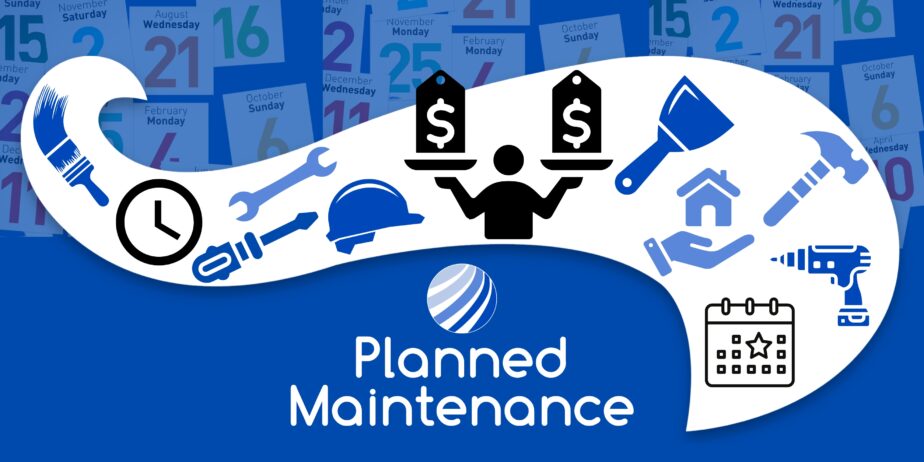In the world of facility & equipment management, the debate between planned maintenance and reactive maintenance is a common one. While both approaches have their place, the benefits of a planned maintenance strategy often outweigh those of a reactive approach. Let’s explore why a planned maintenance plan is the key to efficiency, longevity, and cost savings.
Planned Maintenance is Cost-Efficient
One of the most significant advantages of planned maintenance is cost efficiency. After monitoring over 150,000 man-hours of reactive maintenance, we have observed that the average 8-hour work day only produces 2 1/2 hours of maintenance productivity. Driving from call to call, sourcing needed materials, and developing a plan between stops consumes the other 5 1/2 hours. This non-productive time amounts to annual wasted costs of approximately $82,000 per technician. By implementing a planned maintenance operation, developing a work plan, and sourcing materials prior to deployment, you can increase effective productivity to approximately 7 hours per workday.
Reactive maintenance, although at times necessary, often involves emergency repairs. These repairs can be completed at a significant savings with the right outsourced partner to avoid the nonproductive costs associated with an in-house job and only incur the cost of productive time at partnered favorable hourly rates. Planned maintenance allows for better budget management and reduces the likelihood of unexpected expenses. At Decades, we don’t just believe in the planned approach—we prove it. Our case studies show that a planned strategy is 260% more cost-effective than a reactive one.
Planned Maintenance Increases Asset Lifespan
Your equipment is more than just an asset. It is a long-term investment that requires proper upkeep. Regular maintenance helps extend the lifespan of equipment, ensuring it operates efficiently and reliably. When systems are well-maintained, they perform better and last longer, reducing the need for premature replacements. Reactive maintenance, which only addresses issues after they occur, can accelerate wear and tear, ultimately costing more in the long run. Our strategies help partners get the most out of their investments by prioritizing longevity and reliability.
Planned Maintenance Improves Facility Safety
Safety is a critical concern in any facility. Planned maintenance helps identify and address potential safety hazards before they become serious problems. Routine inspections and preventative measures protect employees, the individuals they serve, and operational integrity. In contrast, reactive maintenance often means safety concerns go unaddressed until they cause an incident, putting employees, the individuals they serve, and operations at risk. With a well-structured maintenance plan, organizations can safeguard both people and mission-critical operations.
Planned Maintenance Enhances Productivity
Unexpected downtime can be a major obstacle to your human services operation. Planned maintenance minimizes unexpected breakdowns and ensures that equipment is always in good working condition. This leads to smoother operations and less disruption to your population. With its unpredictable nature, reactive maintenance can result in prolonged downtime and lost productivity as you wait for repairs to be completed. Efficiency isn’t just a goal, but a necessity, and a planned approach keeps operations moving forward.
Planned Maintenance Allows For Better Resource Management
Planned maintenance empowers you to allocate resources wisely. With planned maintenance, you can schedule repairs and maintenance during off-peak hours, minimizing the impact on your operations and allowing for better resource management. This ensures that your team can focus on their core tasks without constant interruptions. Reactive maintenance often requires immediate attention, pulling resources away from other important activities and leading to inefficiencies. Optimizing resources through strategic planning ensures that your organization can focus on what truly matters.
Planned Maintenance Leads to Data-Driven Decisions
Planned maintenance involves regular monitoring and data collection, providing valuable insights into the performance and condition of your equipment. This data can inform decisions about maintenance schedules, equipment upgrades, and resource allocation. Reactive maintenance lacks this proactive approach, making planning and optimizing your maintenance strategy harder. Leveraging data-driven strategies leads to smarter, more efficient maintenance plans that drive real results, proven by the 260% difference in efficiency between the two approaches.
Conclusion
Reactive maintenance may seem like a quick fix, but in reality, it leads to higher costs, increased downtime, and unnecessary risk. This approach also generates tremendous waste—wasted manpower, wasted facility dollars, and wasted resource potential. Planned maintenance, on the other hand, is the cornerstone of efficiency. It delivers cost savings, extends equipment lifespan, enhances safety, boosts productivity, improves resource management, and enables data-driven decision-making. By adopting a hybrid planned/reactive maintenance approach, you can ensure the long-term success and reliability of your operations.
At Decades, we specialize in providing tailored maintenance solutions that help organizations proactively manage their facilities, ensuring seamless operations and long-term value. Let us help you implement a strategy that maximizes efficiency and protects your bottom line.





